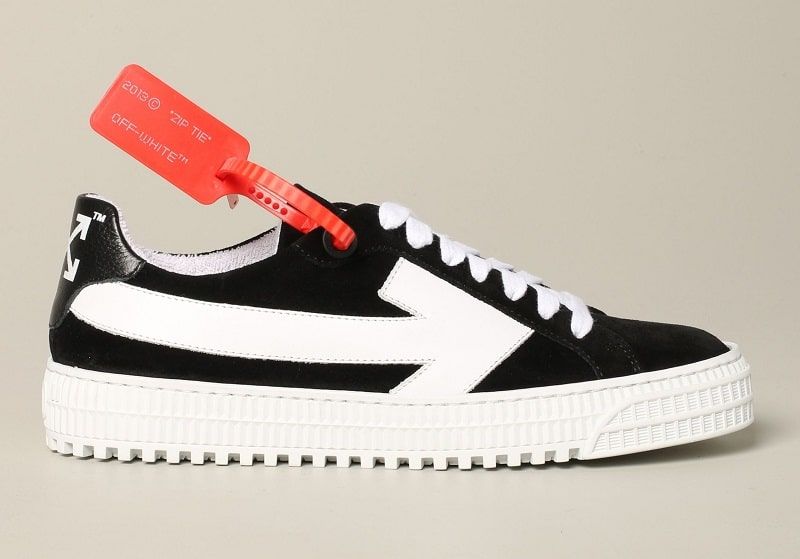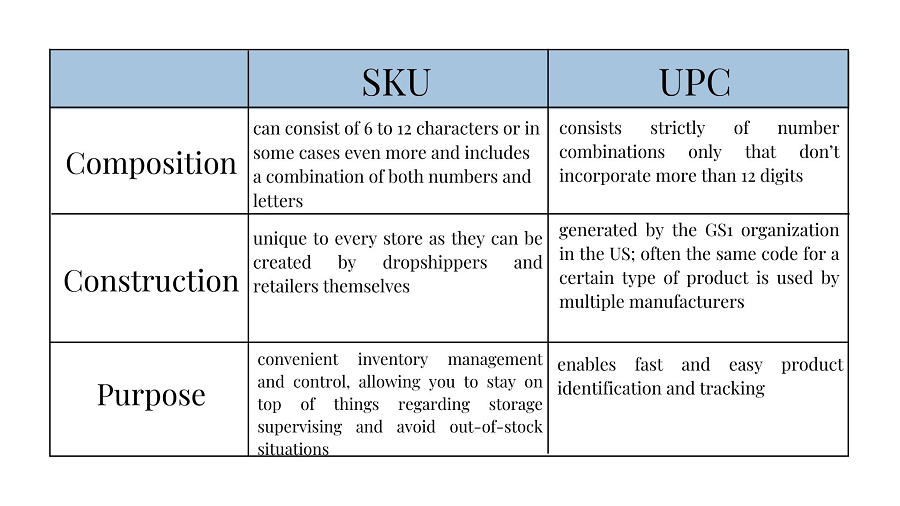SKU vs. UPC: How to Use Them in Your Dropshipping Store
“Being properly prepared is one of the biggest assets in business,’’ claims Keeth Smith, words that’ll keep on ringing true for eternity. In the eCommerce industry, such as the dropshipping sector, this motivational quote particularly highlights the importance of organizing your next steps and managing your store in an efficient way. However, in order to successfully accomplish this, there are a few things dropshippers and other eCommerce owners are bound to pay attention to.
This article focuses on two acronyms many are likely to have heard about but up until now couldn't wrap their heads around their purpose and meaning. We are talking about the terms SKU and UPC. Most sellers are aware that these two names have a massive role in product tracking but only a handful of them truly understand why are they so significant for their businesses.
In the following sections, we’ll be “dissecting’’ this subject thoroughly, delivering you rigorous definitions and accurate examples, and bestowing you with simple clarifications on why you need to use them in your dropshipping store.
:format(webp)/https%3A%2F%2Fbrandsgateway.com%2Fapp%2Fuploads%2F2024%2F06%2Fbanner.jpg)
Looking for a reliable dropshipping or wholesale supplier?
Join us today for top-quality products and unbeatable prices.
What is SKU in a product?
The “stock keeping unit,” or simply known as SKU, is a product code used by both brick-and-mortar and online store owners to keep a record of the merchandise they’re selling. These codes are quite valuable because they allow you to keep track of your inventory and get informed about what exactly goes out of your dropshipping store. In this way, you’re able to keep an eye on your storage levels and avoid product shortages.
A typical SKU consists of alphanumeric characters which can vary in length generated based on a product’s specific attributes such as size, style, color, and other similar characteristics that help retailers differentiate between one item and another. Therefore, you’re granted the liberty to create your own SKU codes depending on how you prefer to organize your inventory.

So, for instance, let’s assume you’ve started a boutique and are dropshipping with luxury apparel company BrandsGateway. This dropshipping supplier offers you their products with already generated SKUs which you can further reuse so you can effectively manage your storage. However, you can also opt for generating your original codes instead of the ones furnished by BrandsGateway if you think it might help you systematize your items easily. If you happen to choose the latter, in the following part, we explain how you can produce unique SKU codes for your store’s products.
How do you create a product SKU?
Now that you know the meaning of SKU and are familiar with its purpose, we’ll walk you through the most efficient and organized way to create these codes.
- Characters. As we’ve already discussed, SKUs are made up of both letters and numbers by combining various product information such as the one mentioned above.
- Formation. Nevertheless, keep in mind that there’s no universal law that dictates the right way to generate a SKU. Some vendors might choose to combine more letters and only a few numbers, others may opt for the opposite. In most cases, however, the first characters almost always refer to the brand or category, while for the rest, it’s up to the retailer.
To give you an illustration, take a look at this example of a unique SKU for the pair of sneakers you see below designed by using relevant product data: OF1527235. The code combination includes the item’s brand name (‘Off-white’) and a few numbers that have been put together based on other criteria that help the retailer to distinguish between its products.


Nevertheless, if you happen to have a large inventory, the manual SKU-creating process can be quite laborious and incredibly time-consuming. Instead, to ease up your job, use convenient automatic SKU generators such as TradeGecko and 3Dsellers. Additionally, if your store is based in Shopify, you can take advantage of the SKUGen app available for a one-time purchase of 9.95$, or the Easy Auto SKU Generator for your WooCommerce-built online business.
What is UPC in a product?
The “universal product code,” also called UPC for short, is a 12-digit combination of numbers assigned to each product in your dropshipping store. These are usually recognizable for their barcode form accompanied with lines that you see attached to all items you’re selling. Since they carry information regarding many product features, the UPCs come extremely in-handy at checkout in pinpointing items that are being sold which helps in keeping an eye on storage quantity.

- Creation. Unlike the SKUs, the UPCs can’t be custom-made. Instead, you’ll have to use the licensed UPC codes your dropshipping supplier provides you with. On the contrary, marketplaces where you can dropship, among which Amazon, eBay, and Facebook, won’t approve your products for sale and you could even get into trouble.
- Purchasing. In the US, UPCs are purchased from the Global Standards Organization, GS1, which is a company in the States that manages and sells these codes to manufacturers. Keeping this in mind, to avoid any inconveniences and legal issues, it’s best to stick to using the UPCs you’re offered by your supplier.
SKU vs. UPC: main differences
Despite being used simultaneously, these two types of product codes do differ from one another, as much in their function as well as in their structure. Based on the explanations we gave above, we’ve summarized the most common differences between the SKUs and UPCs in the hopes of giving you better clarity on the subject and providing you with simple and straightforward descriptions regarding the main features of these codes.
Composition
- SKU: can consist of 6 to 12 characters or in some cases even more and include a combination of both numbers and letters;
- UPC: consist strictly of number combinations only that don’t incorporate more than 12 digits.
Construction
- SKU: unique to every store as they can be created by dropshippers and retailers themselves;
- UPC: generated by the GS1 organization in the US, thus, sellers should use the UPC codes their suppliers provide them with; often the same code for a certain type of product is used by multiple manufacturers.
Purpose
- SKU: convenient inventory management and control, allowing you to stay on top of things regarding storage supervising and avoid out-of-stock situations;
- UPC: enables fast and easy product identification and tracking.

Why are SKU and UPC codes important for your dropshipping store?
In both offline and online businesses, such as dropshipping, SKU and UPC codes offer store owners tremendous assistance in running their businesses. Besides being incredibly helpful in keeping a record of the number of products available and classifying storage items in an orderly and meticulous manner, these two types of code lend you a hand in tackling many other tasks as well, thus, making sure your store stays on the right path and accomplishes the milestones you’ve targeted in your business plan.
Customer convenience
SKUs and UPCs supply your consumers with the greatest shopping convenience ever: quickly locating their desired products in your online catalog by using their allocated SKU or UPC codes. As a result, expect your dropshipping store to be rewarded with positive compliments about your support service and successfully evade unhappy customers. Clients often prefer efficiency and a well-organized search system to help them find the items they need in just a few clicks. Therefore, by having access to SKUs, your customers’ satisfaction will go through the roof.
Inventory control
Inventory control is one of the most fundamental tasks for eCommerce stores. By carefully monitoring any changes their storages go through, online businesses are able to:
- keep a close watch on stock quantity;
- calculate inventory turnover;
- be informed immediately in the case of potential problems.
The SKU and UPC codes simplify this job tremendously by offering you precise inventory reports that can help you track down a particular product in a matter of minutes and keep you posted about any item shortages.

Sales management
With SKUs and UPCs offering you accessible and practical tracking of inventory, you’ll be able to closely observe your dropshipping sales and successfully maintain them. Since these product codes provide you with detailed information about your merchandise, you’d be capable of keeping tabs on high-selling and low-selling items. Thus, this would give you a much-necessary insight into how your products are doing on the market and, consequently, furnish you with the opportunity to take the required actions on time.
In a nutshell
Having now been familiarized with the meaning of UPC and SKU, you can’t overlook the importance of using them for your dropshipping products. They won’t only assist you in managing your sales and inventory levels but also in making sure your customers are offered a convenient method to browse for their favorite products. The SKU and UPC codes make it possible for you to easily navigate storage duties and ensure you offer your clients a pleasant shopping experience.
Related articles
Our clients' success stories speak volumes about the impact BrandsGateway has had on their businesses.
View More Articles








:format(webp)/https%3A%2F%2Fbrandsgateway.com%2Fapp%2Fuploads%2F2024%2F07%2FScreenshot_20240618_140550_Gallery.jpg)
:format(webp)/https%3A%2F%2Fbrandsgateway.com%2Fapp%2Fuploads%2F2025%2F04%2Freview-scaled.jpg)
:format(webp)/https%3A%2F%2Fprod-brandsgateway-images-do.s3.fr-par.scw.cloud%2F2019%2F04%2F6-Best-Men%E2%80%99s-Clothing-to-Sell-in-2019.jpg)
:format(webp)/https%3A%2F%2Fprod-brandsgateway-images.s3.fr-par.scw.cloud%2F2022%2F02%2Finstagram-stories-dropshipping-store-c7eaad24-d54.jpg)
:format(webp)/https%3A%2F%2Fbrandsgateway.com%2Fapp%2Fuploads%2F2025%2F03%2Fstartup-costs-scaled.jpg)
:format(webp)/https%3A%2F%2Fbrandsgateway.com%2Fapp%2Fuploads%2F2025%2F03%2Fgiveaway-scaled.jpg)
:format(webp)/https%3A%2F%2Fbrandsgateway.com%2Fapp%2Fuploads%2F2024%2F06%2Fwindow-display.png)
:format(webp)/https%3A%2F%2Fbrandsgateway.com%2Fapp%2Fuploads%2F2025%2F03%2Fniche-store-scaled.jpg)
:format(webp)/https%3A%2F%2Fbrandsgateway.com%2Fapp%2Fuploads%2F2025%2F03%2Fshopify-chargebacks.jpg)